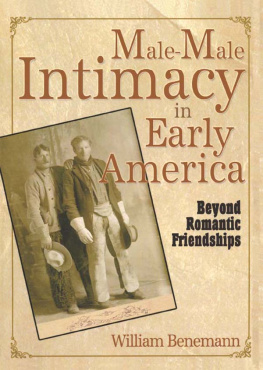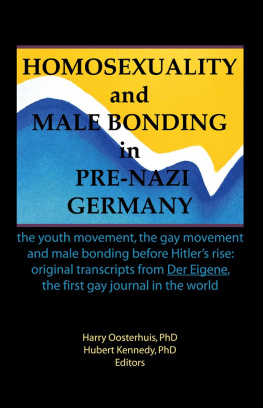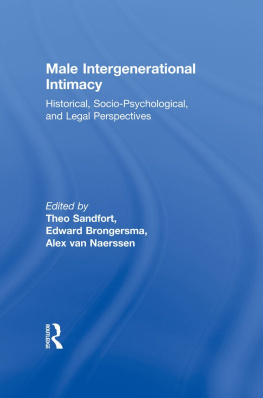Male-Male Intimacy in Early America
Beyond Romantic Friendships
Male-Male Intimacy in Early America
Beyond Romantic Friendships
William Benemann

First published by
Harrington Park Press, an imprint of The Haworth Press, Inc., 10 Alice Street, Binghamton, NY 13904-1580.
This edition published 2012 by Routledge
711 Third Avenue, New York, NY 10017
2 Park Square, Milton Park, Abingdon, Oxon OX14 4RN
2006 by The Haworth Press, Inc. All rights reserved. No part of this work may be reproduced or utilized in any form or by any means, electronic or mechanical, including photocopying, microfilm, and recording, or by any information storage and retrieval system, without permission in writing from the publisher.
Cover design by Lora Wiggins.
Quotations from The Virtuous Curriculum: Schoolboys and American Culture, PhD dissertation, University of Pennsylvania. 1991 Cynthia M. Koch. Used with permission.
Quotations from E. Anthony Rotundo, Romantic Friendship: Male Intimacy and Middle-Class Youth in the Northern United States, 1800-1900, Journal of Social History, 23(1):1-25. 1989 Journal of Social History. Used with permission.
Quotations from Richard Godbeer, The Cry of Sodom: Discourse, Intercourse, and Desire in Colonial New England, William and Mary Quarterly, Third Series, 52(2):259-286. 1995 Omohundro Institute of Early American History and Culture. Used with permission.
Permission has also been granted by the following institutions or organizations to quote from archival materials in their collections: The H. Furlong Baldwin Library of the Maryland Historical Society, Baltimore, Maryland; The Historical Society of Pennsylvania, Philadelphia, Pennsylvania; The Huntington Library, San Marino, California; The Library of Virginia, Richmond, Virginia; The Missouri Historical Society, St. Louis, Missouri; The New-York Historical Society, New York City, New York.
Library of Congress Cataloging-in-Publication Data
Benemann, William, 1949
Male-male intimacy in early America : beyond romantic friendships / William Benemann.
p. cm.
Includes bibliographical references and index.
ISBN-13: 978-1-56023-344-2 (hard : alk. paper)
ISBN-10: 1-56023-344-3 (hard : alk. paper)
ISBN-13: 978-1-56023-345-9 (soft : alk. paper)
ISBN-10: 1-56023-345-1 (soft : alk. paper)
1. Homosexuality, MaleUnited StatesHistory. 2. Male friendshipUnited StatesHistory. I. Title.
HQ76.3.U(United States).x
306.76620973dc22
2005014632
For Kevin
ist, a str, t ceol ar an ngaoth
Is casfar le chile sinn roimh dhul faoi don ghrian
ABOUT THE AUTHOR
William Benemann is Archivist for the School of Law at the University of California, Berkeley, and Adjunct Curator for lesbian, gay, bisexual, and transgender materials for The Bancroft Library at Berkeley. His book A Year of Mud and Gold: San Francisco in Letters and Diaries, 1849-1850 received Library Journals highest recommendation for academic and public libraries. Mr. Benemann has been a contributor to the biographical compilation Gay & Lesbian Literature, as well as a book reviewer for the Journal of the History of Sexuality. He is the founder and current curator of the Gay Bears Collection in The University Archives at Berkeley, an archival collection focusing on the history of sexual minorities at the University of California.
CONTENTS
In spite of the ideology which would have us believe that womens sexuality is an enigma, it is in reality mens bodies, mens sexuality which is the true dark continent of this society.
Rosalind Coward
There were no gay men in America in the eighteenth century.
The statement is obviously false, and yet it is extremely difficult to prove the contrary. If we take one step forward we trip over the stumbling block of semantics. (Gay? Sodomite? Bugger? Homosexual? Queer?) If we push on anyway we hit what appears at first to be a stone wall of evidentiary silence. (Where are the love letters? The diaries? The public documents?) Break through that wall, and we need to come up with an interpretation of the existing evidence that can thread its way between the twin land mines of homophobia on the right and political correctness on the left. Little wonder then that historians of sexuality have shied away from the exploration of this troublesome aspect of early American history. They have found it more attractive to concentrate on Europe, where the topic is better documented and the findings are less ambiguous.
What do we mean when we talk about homosexuality in eighteenth-century America? The word homosexual itself was not coined until the late nineteenth century, and it is admittedly difficult to conceptualize Americans being something without having a word for it. In the period under discussion the words most commonly used for the concept were sodomite (from a misunderstanding of the sin of the people of Sodom) or bugger (a reference to an eleventh-century Bulgarian sect which professed the Manichaean heresy and refused to engage in procreative activities). Both terms referred to participants in male-male sexual activity (along with a host of other meanings), but neither carried the modern sense of sexual orientation. It would have been meaningless in the eighteenth century to talk about a latent sodomite or a bugger orientation. Action was everything. But that is not to say that men who felt a strong sexual and emotional attraction to other men were unaware that those feelings set them apart from the majority of Americans, or that they did not know that there were others just like them, fellows who shared their minority status.
Even if it were possible to fix on an acceptable definition of homosexuality when speaking of eighteenth-century America, the historian is still faced with a gaping void when it comes to documentation. Homosexuality has been labeled the crimen inter Christianos non nominandum, the sin not to be named among Christians, the unspeakable crime against nature, the love that dare not speak its name. Woven into Western societys attitude toward homosexuality is the imperative of silence. Men (and, to a much lesser extent, women) were condemned and executed for committing an act their accusers would not specify, for fear that even uttering the word would create scandal. Throughout the American colonial period and well into the early years of the Republic the penalty for sodomy was death, so it is not surprising that men who sought other men as sexual partners did not advertise their activities, and left behind little evidence which might be used against them in a court of law. But evidencehowever obscureddoes exist. The problem arises with interpretation.
If we open a letter written by a young woman and read, Often too he shared my pillowor I his, and how sweet to sleep with him, to hold his beloved form in my embrace, to have his arms about my neck, to imprint upon his face sweet kisses, we can reasonably assume that she and the man in question shared a sexual relationship. There is no justifiable grounds for changing that assumption when we learn that the words were actually written by Albert Dodd, a Yale undergraduate in the 1830s, describing his relationship with a fellow student, Anthony Hall.
I will give one example of the genre, not because it is outstandingly egregious, but because the book in question is an otherwise-excellent biography of an eighteenth-century American who plays a minor role in the current study. A recent biography of John Laurens, son of the president of the Continental Congress Henry Laurens, is quite frank about the young mans passionate attachment to men and his clearly secondary interest in women.
Next page





